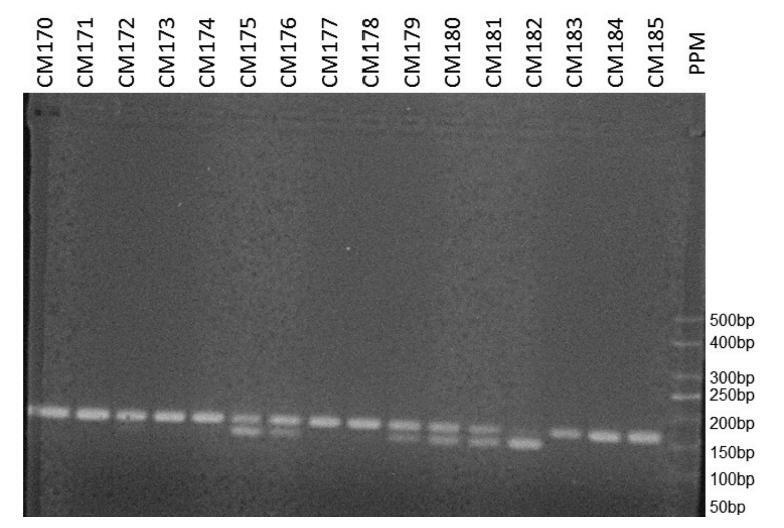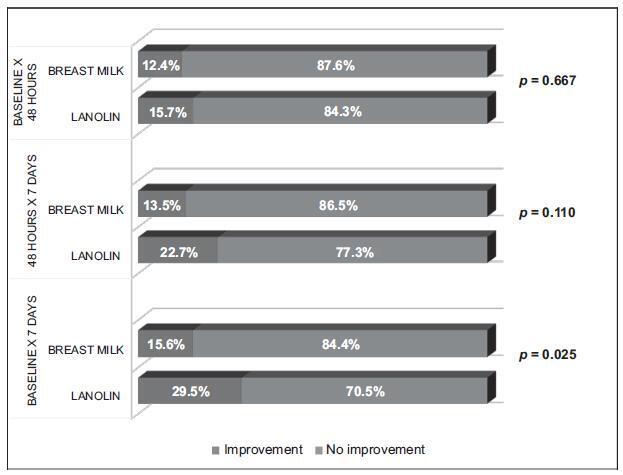Summary
Revista Brasileira de Ginecologia e Obstetrícia. 2018;40(11):699-704
Epidemiological studies have shown evidence of the effect of sex hormones in the pathogenesis of breast cancer, and have suggested a relationship of the disease with variations in genes involved in estrogen synthesis and/or metabolism. The aim of the present study was to evaluate the association between the CYP3A4*1B gene polymorphism (rs2740574) and the risk of developing breast cancer.
In the present case-control study, the frequency of the CYP3A4*1B gene polymorphism was determined in 148 women with breast cancer and in 245 women without the disease. The DNA of the participants was extracted from plasma samples, and the gene was amplified by polymerase chain reaction. The presence of the polymorphism was determined using restriction enzymes.
After adjusting for confounding variables, we have found that the polymorphism was not associated with the occurrence of breast cancer (odds ratio = 1.151; 95% confidence interval: 0.714–1.856; p= 0.564). We have also found no association with the presence of hormone receptors, with human epidermal growth factor receptor 2 (HER2) overexpression, or with the rate of tumor cell proliferation.
We have not observed a relationship between the CYP3A4*1B gene polymorphism and the occurrence of breast cancer.

Summary
Revista Brasileira de Ginecologia e Obstetrícia. 2018;40(11):693-698
The aim of the present study is to identify the association between personality traits of postmenopausal women and the occurrence of sexual dysfunction.
A total of 43 postmenopausal women were evaluated according to their self-perception of the quality of their sexual life. They answered the following questionnaires: Sociodemographic Profile Questionnaire, Female Sexual Function Index (FSFI), Beck Depression Inventory (BDI) and Factorial Personality Inventory (FPI-II).
Women with poorer sexual self-perception showed low affective need (p< 0.01) and low need for organization (p< 0.01). Based on the need for control and opposition, there was no difference between the groups. Groups separated by the scores obtained on the FSFI showed no significant differences.
Postmenopausal women with lower schooling and personality characteristics that demonstrate low affective and organizational needs are more likely to present sexual dysfunction.
Summary
Revista Brasileira de Ginecologia e Obstetrícia. 2018;40(11):686-692
The aim of the present study was to assess the anthropometric measures, food intake and food cravings during the menstrual cycle of undergraduate students of the faculty of nutrition.
A cross-sectional study was performed with 27 students from a public university in the state of Mato Grosso do Sul, Brazil, who had their food intake evaluated through a 24-hour food recall, their nutritional status evaluated based on anthropometric measures, and food cravings evaluated using the Food Desire Questionnaire. Data were collected during an evaluation in the follicular phase (between the 5th and the 9th day of the menstrual cycle) and another in the luteal phase (LP) (between the 20th and the 25th day of the menstrual cycle). For food intake variables, the analysis of variance (ANOVA) test was used, followed by the Tukey test. The Mann-Whitney test was used for the analysis of food cravings, considering a significance level of 5% (p< 0.05).
The desire for foods rich in sugar, salt, and fat, such as chocolate, pastries, snacks and desserts were higher (p< 0.05) during the premenstrual period, although it did not reflect neither a higher energy intake nor an alteration in the distribution of macronutrients. A higher intake of carbohydrates, proteins, fibers, and calcium was observed during the LP; however, without statistical difference between the groups. There were no differences either in the intake of any food group or in the anthropometric measurements (p> 0.05).
Food cravings of nutrition students differed between the phases of the menstrual cycle; however, with no difference in food intake and in anthropometric measures.

Summary
Revista Brasileira de Ginecologia e Obstetrícia. 2018;40(11):680-685
Our aim is to demonstrate the importance of methotrexate (MTX) therapy for the treatment of ectopic pregnancy (EP).
This retrospective study consisted of 99 patients (72 tubal EPs, 20 pregnancies of unknown location (PUL), 4 cesarean section (CS) scar EPs and 3 cervical EPs) treated with MTX.
Methotrexate therapy was successful in 68.5% of EPs. There were statistically significant differences between the MTX success and failure groups based on ultrasonographic findings, patient complaints, gestational week and serum human chorionic gonadotropin (hCG) values. The MTX success rates in PUL and tubal pregnancies were 95% and 61.1%, respectively. The MTX success rates in single-dose, two-dose and multi-dose protocol groups were 86.9%, 28.6% and 40%, respectively. All cervical and CS scar ectopic pregnancies were treated successfully with MTX therapy.
Methotrexate might be the first-line treatment option for EPs under certain conditions. Physicians must be more cautious in cases with higher hCG values, the presence of abdominal-pelvic pain, the presence of fetal cardiac activity, larger gestational sac (GS) diameters, and more advanced gestational weeks according to the last menstrual period.
Summary
Revista Brasileira de Ginecologia e Obstetrícia. 2018;40(11):673-679
The aim of this study was to analyze and compare obstetric and neonatal outcomes between Syrian refugees and ethnic Turkish women.
Retrospective, observational study. A total of 576 Syrian refugees and 576 ethnic Turkish women were included in this study, which was conducted between January 2015 and December 2015 at a tertiary maternity training hospital in Ankara, Turkey. The demographic characteristics, obstetric and neonatal outcomes were compared. The primary outcomes were pregnancy outcomes and cesarean rates between the groups
The mean age was significantly lower in the refugee group (p< 0.001). Mean gravidity, proportion of adolescent pregnancies, proportion of pregnant women aged 12 to 19 years, and number of pregnancies at < 18 years were significantly higher among the refugee women (p< 0.001). Rates of antenatal follow-up, double testing, triple testing, gestational diabetes mellitus (GDM) screening, and iron replacement therapy were significantly lower in the refugee group (p< 0.001). The primary Cesarean section rate was significantly lower in the refugee group (p= 0.034). Pregnancies in the refugee group were more complicated, with higher rates of preterm delivery (< 37 weeks), preterm premature rupture of membranes (PPROM), and low birth weight (< 2,500 g) when compared with the control group (4.2% versus 0.7%, p< 0.001; 1.6% versus 0.2%, p= 0.011; and 12% versus 5.8%, p< 0.001, respectively). Low education level (odds ratio [OR] = 1.7, 95% confidence interval [CI] = 0.5–0.1), and weight gain during pregnancy (OR = 1.7, 95% CI = 0.5–0.1) were found to be significant indicators for preterm birth/PPROM and low birthweight.
Syrian refugees had increased risks of certain adverse obstetric outcomes, including preterm delivery, PPROM, lower birth weight, and anemia. Several factors may influence these findings; thus, refugee women would benefit from more targeted care during pregnancy and childbirth.
Summary
Revista Brasileira de Ginecologia e Obstetrícia. 2018;40(11):664-672
To compare two different treatments—the use of highly purified anhydrous (HPA) lanolin and expressed breast milk—for women with pain and nipple trauma during the breastfeeding process.
A total of 180 puerperal women were randomly assigned to 2 groups: one was treated with HPA lanolin and the other with their own expressed breast milk. All of the participants received the same breastfeeding technique instructions and therapeutic care standard. Three assessments were performed: at the time of inclusion in the study (after randomization); after 48 hours; and after 7 days. At each interval, data was collected in relation to pain and trauma. A numerical/verbal category scale was used for the pain variable, and the nipple trauma score for the trauma variable. The results were subjected to statistical analysis using the chi-squared test, the Fisher exact test, the student t-test, and the Kolmogorov-Smirnov test. Generalized estimating equations were calculated using the STATA 12 statistical software package (StataCorp LLC, College Station, TX, USA) and IBM SPSS Statistics for Windows, Version 20.0 (IBM Corp, Armonk, NY, USA).
There was pain improvement from the second to the third assessment in the group that used HPA lanolin, while the pain remained unchanged between these two periods (p< 0.001) in the breast milk group. In terms of trauma, improvement was identified in its extension and depth from the first to the third assessment, and it was higher in the HPA lanolin group than in the breast milk group (p= 0.025).
The treatment of pain and nipple trauma with HPA lanolin achieved better results than the one with breast milk, based on a 7-day treatment period.

Summary
Revista Brasileira de Ginecologia e Obstetrícia. 2018;40(9):513-517
Induction of labor (IL) is a common obstetric procedure, but it is questionable whether or not it results in higher cesarean section (CS) rates. The present study aims to evaluate the impact of IL in the overall CS rates and to analyze these rates according to the method of IL employed and to the Robson group in which it was applied.
We have conducted a retrospective study including pregnant women whose labor was induced at a tertiary hospital in 2015 and 2016. All women were classified according to the Robson Classification System (RCS). The CS rates were analyzed and compared regarding the method of IL employed.
A total of 1,166 cases were included. The CS rate after IL was 20.9%, which represented 23.1% of the total of CSs performed in 2015 and 2016. The highest CS rates were recorded in RCS groups 5 (65.2%) and 8 (32.3%). Group 2 was the highest contributor to the overall CS rate, since it represented 56.7% of the population. The intravaginal prostaglandins method was the most used (77%). Transcervical Foley catheter was the preferredmethod in group 5 and intravaginal prostaglandins in all the other groups. The CS rate was higher when transcervical Foley catheter was used (34.1%).
Transcervical Foley catheter induction was associated with a higher rate of CS, probably because it was the preferred method used in group 5.
Summary
Revista Brasileira de Ginecologia e Obstetrícia. 2018;40(9):507-512
To analyze the use of the measurement of uterine cervix length (MUCL) and the fetal fibronectin (fFN) rapid test as predictors of preterm delivery (PTD) in symptomatic pregnant women assisted at the Santa Casa de Misericórdia de Sobral Maternity Hospital.
This was a prospective and analytic study involving 53 parturients assisted between September of 2015 and July of 2016; the participants were between 24 and 34 weeks of gestational age (GA) and presented complaints related to preterm labor (PTL) prodromes. Vaginal secretion was collected for fFN testing, and the MUCL was obtained via transvaginal ultrasonography.
A total of 58.49% of the subjects showed MUCL < 25 mm, and 41.51% were positive in the fFNrapid test.Atotal of 48 patients were followed-up until their delivery date, and 54.17% resulted in PTL. The relative risk (RR) for PTD in patients with MUCL < 25 mm was 1.83 (p = 0.09, 0.99-3.36, 95% confidence interval [CI]), with a mean time before delivery of 2.98 weeks. Based on fFN positive results, the RR was 3.50 (p = 0.002, 1.39- 8.79, 95%CI) and themean time until delivery was 1.94weeks. The RRwas 2.70 (p = 0.002, 1.08-6.72, 95%CI) when both tests were used. The RR of PTD within 48 hours, and 7 and 14 days were, respectively, 1.30 (p = 0.11, 95% CI 1.02-1.67), 1.43 (p = 0.12, 95% CI % 0.99-2.06), and 2.03 (p = 0.008, 95% CI 1.26-3.27), when based on the MUCL, and 1.75 (p = 0.0006, 95% CI 1.20-2.53), 2.88 (p = 0.0001, 95% CI, 1.57-5.31), and 3.57 (p = 0.0002, 95% CI 1.63-7.81) when based on positive fFN results. The RR at 48 hours and 7 and 14 days considering both tests was 1.74 (p = 0.0001, 95% CI 1.14-2.64), 2.22 (p = 0.0001, 95% CI 1.22-4.04), and 2.76 (p = 0.0002, 95% CI 1.27-5.96), respectively.
In symptomatic pregnant women, we concluded that the MUCL < 25 mm associated with positive fFN rapid test indicate increased the risk for PTD. Further studies with larger sample sizes could contribute in supporting the results presented in the current study.